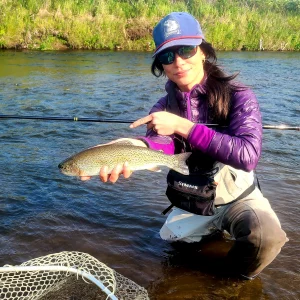
In this write-up we’ll talk about the Pause and Drift. It’s as easy as it sounds, promise.
Condensed down to the bare bones, a Pause and Drift Presentation is a dead drift in which you occasionally stop, to intentionally add action to your fly, then proceed again with another dead drift, repeating this process every several feet in order to get the most bang for your buck. This presentation can be done with dry flies, nymphs and even emergers. I think of it as covering all my bases.
When we think of dry flies, we usually think of a dead drift – our fly motionless on the surface of the water. But there are many insects that while drifting, have behaviors that involve action. These behaviors include drying their wings, laying eggs or preparing to take off. All of these actions are achieved through different motions, such as self-propelling across the water, hopping, twitching or plopping. And all of these actions, can be closely mimicked with the sensitive tip of a tenkara rod.
Dead drifts are productive and widely used. But they are still and lifeless and give the fish ample time to inspect, and suspect, the fly. Some of the insects we imitate are dead, but some are very much alive…or coming to life as they make their way up the water column or ride on the surface. Pairing a Dead Drift Presentation with an occasional slight action, adds a dimension of life to a fly that addresses and imitates live insects. To do the Pause and Drift, you are only limited by the water and environmental conditions, and of course your fly choice.
We can become so consumed by the delicacy of our tenkara rods, that we forget the obvious: Grasshoppers and big terrestrials don’t land on the water surface softly. They land with a plop. They may get stuck in the surface foam because of their size, but they twitch and move attempting to get free. Other insects like caddis, have to release the water surface tension prior to taking off, and hop slightly to do this. Other bugs that are found on the surface of the water are there releasing their eggs, and bounce to do this.
Nymphs and emergers too, are not always static in the water. As insects hatch, they squiggle, pulse and drift. Animation and movement are often game changers and when periodically combined with a dead drift, procure greater interest and striking instinct from fish.
So, the next time you are on the river and begin a simple dead drift, take a look around and notice the insects on the surface of the water. Are they completely and utterly motionless? On your next cast, drift your fly several feet, then pause and add a slight motion or wiggle to your fly…maybe a slight up and down movement or a twitch by a small tap on your rod, then stop and continue your dead drift. Continue to alternate every few feet between stillness and animation throughout your entire swing. You may be very surprised by the improved result and additional strikes you get from hungry fish driven by instinct and attracted to movement and behaviors.
Condensed down to the bare bones, a Pause and Drift Presentation is a dead drift in which you occasionally stop, to intentionally add action to your fly, then proceed again with another dead drift, repeating this process every several feet in order to get the most bang for your buck. This presentation can be done with dry flies, nymphs and even emergers. I think of it as covering all my bases.
When we think of dry flies, we usually think of a dead drift – our fly motionless on the surface of the water. But there are many insects that while drifting, have behaviors that involve action. These behaviors include drying their wings, laying eggs or preparing to take off. All of these actions are achieved through different motions, such as self-propelling across the water, hopping, twitching or plopping. And all of these actions, can be closely mimicked with the sensitive tip of a tenkara rod.
Dead drifts are productive and widely used. But they are still and lifeless and give the fish ample time to inspect, and suspect, the fly. Some of the insects we imitate are dead, but some are very much alive…or coming to life as they make their way up the water column or ride on the surface. Pairing a Dead Drift Presentation with an occasional slight action, adds a dimension of life to a fly that addresses and imitates live insects. To do the Pause and Drift, you are only limited by the water and environmental conditions, and of course your fly choice.
We can become so consumed by the delicacy of our tenkara rods, that we forget the obvious: Grasshoppers and big terrestrials don’t land on the water surface softly. They land with a plop. They may get stuck in the surface foam because of their size, but they twitch and move attempting to get free. Other insects like caddis, have to release the water surface tension prior to taking off, and hop slightly to do this. Other bugs that are found on the surface of the water are there releasing their eggs, and bounce to do this.
Nymphs and emergers too, are not always static in the water. As insects hatch, they squiggle, pulse and drift. Animation and movement are often game changers and when periodically combined with a dead drift, procure greater interest and striking instinct from fish.
So, the next time you are on the river and begin a simple dead drift, take a look around and notice the insects on the surface of the water. Are they completely and utterly motionless? On your next cast, drift your fly several feet, then pause and add a slight motion or wiggle to your fly…maybe a slight up and down movement or a twitch by a small tap on your rod, then stop and continue your dead drift. Continue to alternate every few feet between stillness and animation throughout your entire swing. You may be very surprised by the improved result and additional strikes you get from hungry fish driven by instinct and attracted to movement and behaviors.




Yes, it’s a deadly technique. But don’t overdo it. A very small or short movement is more than enough. You will catch the fish and not to scare it to death. 😉
Yes! Exactly. Which is why tjis works so well with a tenkara rod – you can create very very slight movements so as you said, don’t scare the fish to death. Wonderful!
Kind of like when you are dredging the bottom, with a nymph, you use a slow lift to start your take out.
Yes. It’s just a simple reminder that not everything in the water is lifeless. Sometimes we get so caught up making that perfect motionless drift, that we actually miss fish because its too perfectly still.
And thanks for reading!
Also some of a stream will do the movement for us. I am inclined to overwork the fly and on occasion trout have left the pool completely by speeding off downstream
Kevin agree. Movements need to be very slight or you might spook the fish…and tenkara is the perfect tool to create those micromovements with. We’ve all spooked a few fish, lol.